Deserved immortality: games that did not let you get bored
Sometimes you sit down at your desktop, look at a fancy laptop and think: oh, I would have it, yes, 20 years ago, so that in three nights - and all the levels! Indeed, it doesn’t turn out to be possible to return to the past, in which there were favorite games and heroes, simple graphics, a fascinating plot. But, as you know, real art does not die, and we have not just emulators, but real releases of those very games that have passed through us through youth and youth. And, damn it, how pleasant this nostalgia is, how familiar the heroes are, how close places and events are. The past has never been so close - for a moment we felt: a time machine exists. Go? Find them all! Click to enlarge
Guys, Levelord captured us - literally conquered us with our revelations in an interview
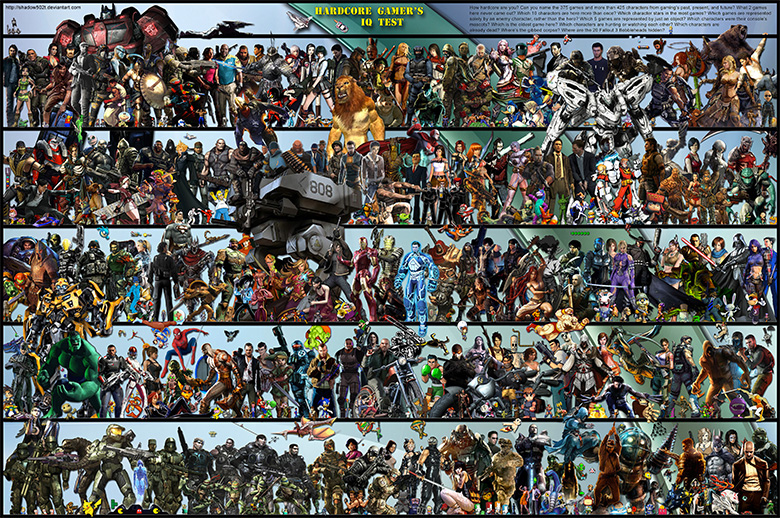
. And most importantly, he and the history of the legendary, such a native and colossal Duke Nukem, inspired us to a small leap into the past. Today we decided to devote our post to computer games that are more alive than all living ones: they are still supported or have survived a rebirth. We will give only a few legendary examples, in fact there are a lot of them - the community is literally overwhelmed with such phenomena. And this, of course, is not without reason.
Why do games from the past come in this way, why is there a need for their revival? Everything is simple - our brain and social factor work.
But the developers have fanaticism, of course, but to a lesser degree: most often the old new game comes out as an attempt to make money on those who miss the games of youth. However, what is the difference that drives them - the main thing is that it turns out very cool and with a soul. And it’s not a sin to pay for it.
These and several other games still occupy their place in the community, excite the universe of computer games and are even used for e-sports competitions. One thing summarizes them - a unique, interesting game logic that does not leave indifferent neither experienced (I'm not afraid of the word - old) players, nor the younger generation, who is looking for digital retro among the colorful design world.
→ Two very important links for those who are skilled in gamedev or just want to play at little cost:
You can join the community and not just play, but also create a game world.
In November 2016, the NES cult prefix, first introduced to the world in 1983, was re-released; in 2017, the Sega Genesis console (Sega Mega Drive update) returned from legendary nonexistence. In 2016, Hyperkin launched Hyperkin Smart Boy - a “cover” for a smartphone with old-school keys for game consoles and support for old cartridges. This is all - nostalgia for the very gadgets, which is always in demand. With games, the same story is only more exciting, with millions of dollars and a super warlike community.
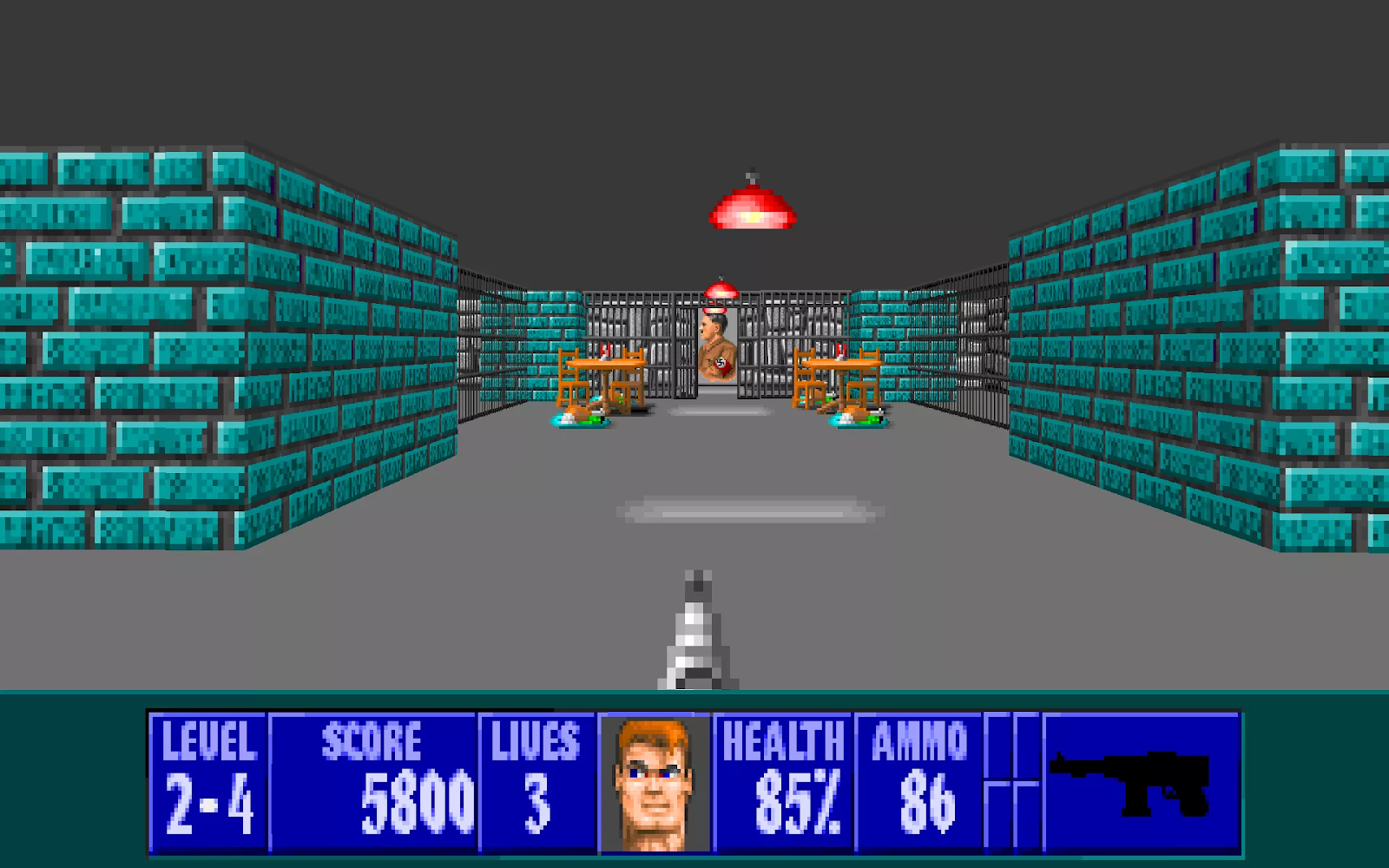
The Wolfenstein series of games is one of the long-livers of the gaming market that has had a huge impact on the development of first-person shooters. Games have come a long way: from two-dimensional action games to modern shooters with advanced graphics. The first game in this series from the developer Muse Software was released in 1981 in the genre of stealth action. The plot of the game was dedicated to the events of the Second World War: the scout carried out his mission in the Wolfenstein castle in the deep German rear, he had to steal secret documents and leave the castle. Two options for the gameplay were available for the player: to pass through the castle quietly, spyly and steal data or go “loudly”, killing enemies in their path.
However, the arsenal for fighting enemies was so-so: a ten-shot pistol and grenades. In 1984, Beyond Castle Wolfenstein was released - the continuation of the first game with a more difficult task - to get to the Fuhrer’s bunker and detonate a bomb near the meeting room, where the Third Reich leadership is sitting. Passes, achievements, bonuses appeared in the game. After 6 years, Wolfenstein 3D (almost the progenitor of all first-person shooters) was released from id Software (who gained their fame thanks to Doom and Quake). The spy hero finally got a name - William “BJ” Blaskowitz, but the stealth action genre was almost lost, and instead a wall of opponents and a whole arsenal of weapons, often not related to World War II. In the end, they had to kill ... mechanized Hitler. In 2001, a version with adequate 3D graphics was released Return to Castle Wolfenstein.
The 2009 release was unsuccessful and the disappointment of the fans lasted for five years, until Wolfenstein: The New Order was released in 2014. This was a version with an unusual plot - events met the players in 1946 and in 1960, in the conditions of the absolute victory of fascist Germany. Especially the game was distinguished by the types of familiar places and personalities in conditions of unusual German reality. Such a breakdown in the course of history in virtual reality is the merit of the gaming studio MachineGames (Sweden). Then there were a couple of pass-through releases, returning the players to the first versions of the “castle”, but ... here we will not spoil - suddenly you did not play. In 2017, a new cool release was released and, it seems, that's not all.
By the way, everything was criticized by the authorities and the public (apparently not particularly playing): from the soundtracks of fictional groups appealing to The Beatles, to the swastika and extremely cruel scenes.
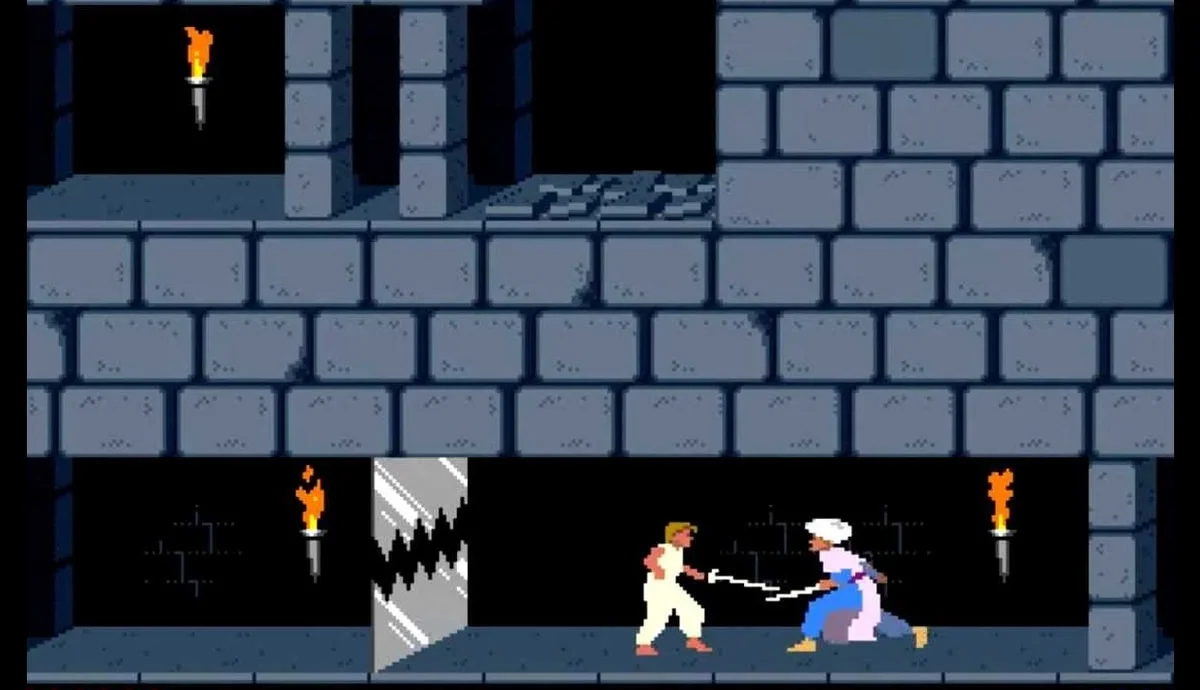
But this is our game, the game of the happy owners of Dendy from the 90s. Prince of Persia appeared to the world on October 3, 1989 and shocked everyone primarily with its animation. It was not just a game, it was also a high-quality cartoon. This unique animation was achieved due to the deeply worked out anatomy of the character - the developer John Mekner sketched movements literally from nature - from his brother. In the Prince of Persia action adventure, all the salt was primarily in all sorts of puzzles that the player solved for the hero.
The second series of Prince of Persia was distinguished by improved graphics and liked the army of fans, but the third and fourth (already reincarnation in 3D) were already a complete failure. John Mekner closed the project a decade after the first release, in 1999. In the 21st century, gamers entered without the Prince of Persia.
But, fortunately for the gaming universe, there is Ubisoft (yes, those that, according to a new legend, should help rebuild Notre Dame Cathedral in Paris - by the way, read an excellent interview on this subject) So, in 2003, Ubisoft bought the rights to the game and released the fourth breakthrough release - Prince of Persia: The sands of time. This and subsequent games were distinguished by gorgeous graphics and crazy movements of the heroes - but there was no longer that lamp-like creation of John Meckner, in front of which his sibling was jumping, unfolding, taking cool poses. The latest release in HD took place in 2010. And this, perhaps, is an outsider of our post - although it was reborn and powerful, the game remained a legend for fans, but did not find a huge number of new fans. If you are a fan of classic games, be sure to try.
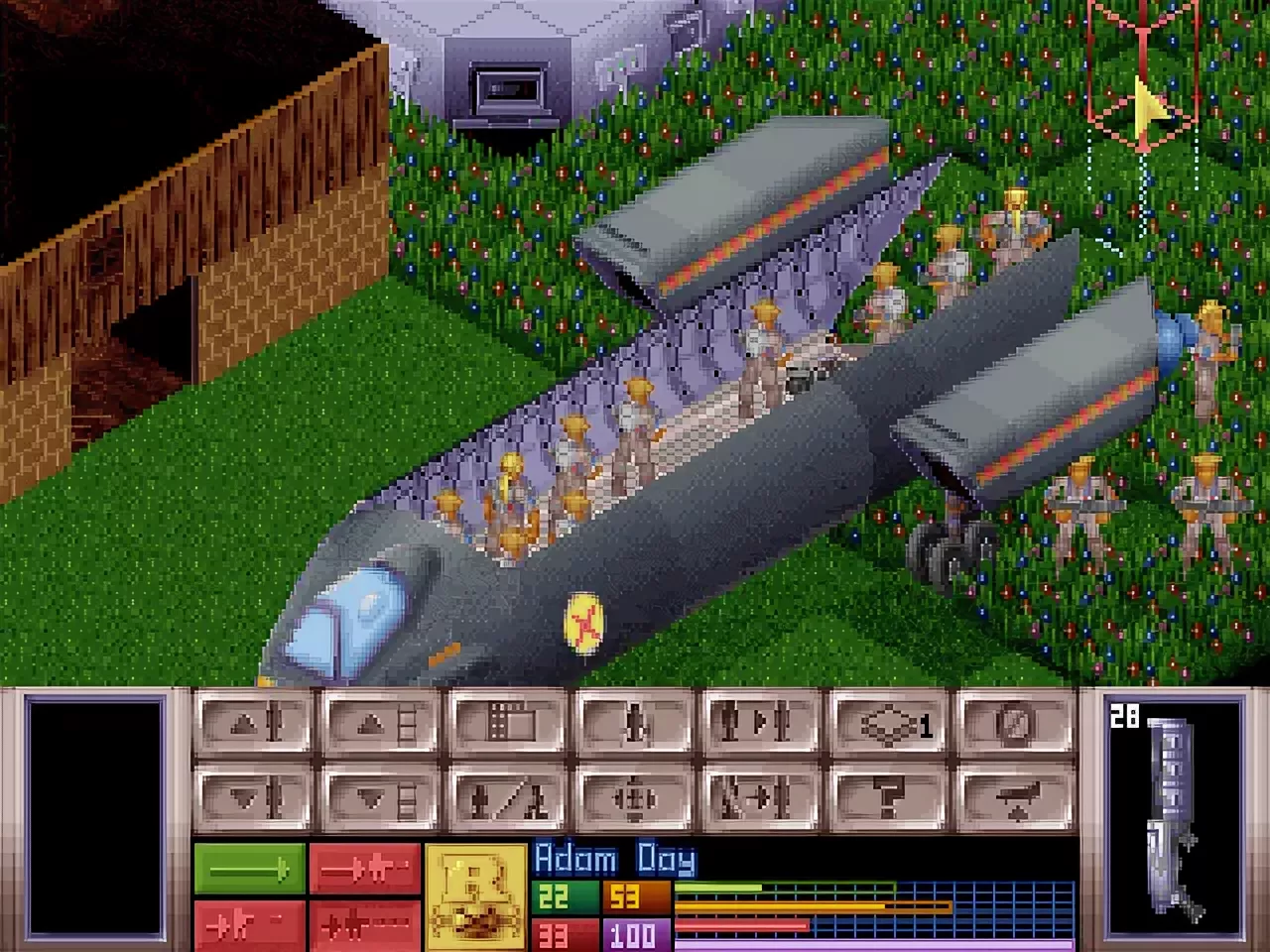
The first game “X-COM: UFO Defense” was released in 1993 and immediately received the common abbreviated name UFO. The game came out in the format of a very complex, well-developed strategy and required an extraordinary intelligence and perseverance from the player. Players defended the planet from an invasion of aliens, trying to save every available resource. The game quickly conquered the market and spawned a lot of its copies, each of which could not be compared with the original release. And ... everything, for two long decades the game never got a decent continuation or a remake, moreover, in 1998 the project was essentially closed. Yes, and I thought, is there life in the most complex turn-based strategy in the world where shooters, 3D versions and other actions are being developed?
But the fan base could not sleep well if it hadn’t done something like that, having received new development tools in the second decade of the 21st century. In 2012, XCOM: Enemy Unknown was released, and a little later, XCOM: Enemy Within by Firaxis Games. The developers carefully reacted to the gameplay, but somewhat simplified the interface to make it more accessible to a wide range of users. However, the game retained two most important features: complex tactics and strategy, requiring active thinking and “clannishness” (each fighter is the most important coherent unit, without which the continuation of the battle is a tragedy).
But 2015 brought serious tactical changes and something tells me, not the last. This is perhaps one of the most striking examples when the revived version turned out to be not only no worse, but also able to overcome the illness of the original and elevate it to the degree of its dignity.
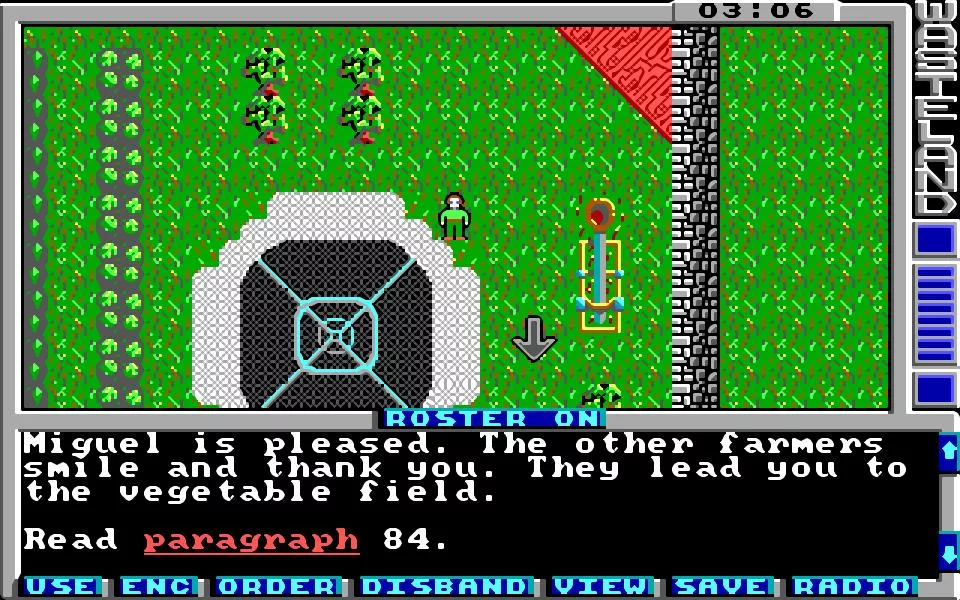
Wasteland is a 1988 post-apocalyptic role-playing game created by Alan Pavlish, Michael Stackpole and Ken Andre for Interplay Entertainment. This game has become for its time not just a legend, but a real cult. In part, you can say that Wasteland is an echo of the Cold War: the game takes place in 2087, 10 years after the end of the nuclear war between the USA and the USSR, which, according to legend, lasts no more than an hour.
Rangers from the game have to not only find half-extinct settlements, but also perform the main task - to fight against out-of-control artificial intelligence, which creates an army of robots and cyborgs to fix the remnants of the human race. The game was originally released for Apple II, Commodore 64, and IBM PC.
The game had a feature - it was hybrid. The paper manual was attached to the game with paragraphs that were intended to clarify the player some points on the plot of the game. It was necessary to turn to paragraphs at the moment when the game itself suggested it (the trigger worked). By the way, in those days the game received a very colorful interface and cool design.
In 2003, InXile Entertainment (led by Wasteland producer Brian Fargo) acquired the rights to Wasteland from EA, and Fargo spoke about the revival itself only in 2007, but then fell silent for another 5 years.
On March 13, 2012, Brian Fargo launched a crowdfunding fundraising campaign on Kickstarter to develop the sequel to Wasteland 2. More than $ 1 million was raised in 2 days. Given a collection of $ 2.1 million, Obsidian employees and Chris Avellone personally promised to join the development. April 17, the collection was over - with a result of more than $ 3 million. At the end of 2016, the round of training at Wasteland 3 brought the same amount.
Fargo turned out to be the very man who revived the game in many respects for the sake of the players themselves - his team worked to their conscience: the game received an old-fashioned isometric view, long dialogs, difficult tasks. Many began to compare the new version with Fallout, which is not surprising - Wasteland is considered the forerunner of Fallout.
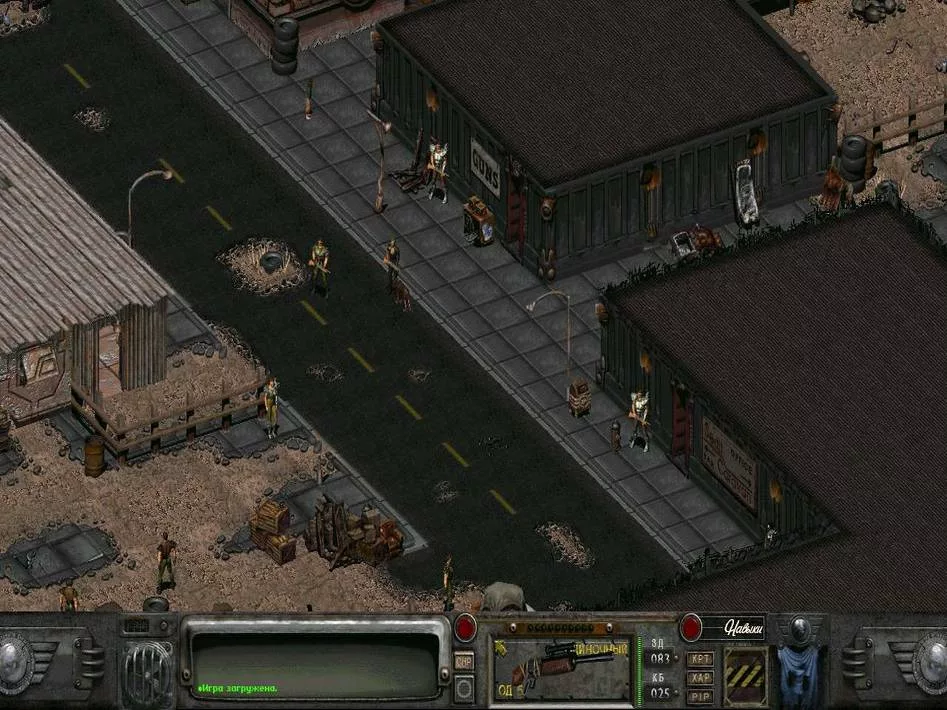
By the way, Fallout itself is also a game with a difficult fate. Although this is a relatively young game (the first release took place in 1997), after the first two releases, players and fans froze in a long ... long, long wait. In 2001, the game world stirred up the Fallout 3 project, codenamed Project Van Buren, but it never came out - fans just licked at the demo version. In 2007, Bethesda Softworks bought all rights to Fallout and opened a pandora’s box: Fallout 3 came out in 2008, conquered young players and angered old ones - it wasn’t their game. However, the release was successful and won a lot of fans. The noise didn’t scare the company (it’s on her hand), and in 2015 Fallout 4 came out to everyone’s joy (Habré also had enough noise about this). The result was a huge, amazing world with a bunch of quests, insanely cool graphics and other chips. However,
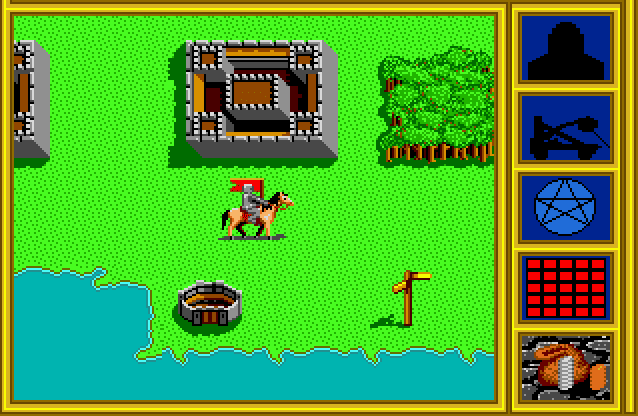
We decided to mention King's Bounty game, because this game turned out to be closely connected with Russia and got its rebirth thanks to 1C. King's Bounty is a 1990 turn-based strategy by the author of Heroes of Might and Magic John van Canegam. This is practically a knightly ballad on the game screen: adventures, knights, dragons, mysterious lands. The developer made a unique game for his time both in terms of gameplay and in terms of design, but was not going to continue to support and develop it.
But the programmer Sergey Prokofiev from Kharkov decided to do this - it was he who created the unofficial continuation of the game. Accordingly, it was his King's Bounty 2 that became popular in the entire post-Soviet space - for the most part because it was released in Russian.
Much later, in 2007, 1C acquired the rights to the game, found a developer for development, and restarted the entire series with the release of “King's Bounty. The Legend of the Knight. " The classic RPG came out successful and still exists, although it is not developing so actively.
These games outwitted history and overcame time only because each of them was somehow the first, had unique game mechanics, gathered around itself a strong and devoted community. We can say that then they did real things, and now ... Well, no, progress does not stand still, now we see realistic graphics, augmented and virtual reality, strong stories, almost living characters. Now game design and game dev are cultured and give birth to no less iconic products. It’s just us, 30-40-45-year-olds, who are tormented by one question: “Where are my 17 years?” And with those games we are again 17. You just believe, and understand later.
And this time we have not a cool banner with a promotional code, but an entire action!
June 1, we held the Duke Con festival in St. Petersburg, dedicated to the 22nd anniversary of the release of the game Duke Nukem 3D. Duke Nukem aka Nuclear Duke - the legendary computer game, one of the iconic in the industry.
In honor of this event, we decided to hold a summer promotion for RUVDS clients. In June, we increase the discount when paying for the year to 30%. All customers who paid for the year from June 1 to 30 will also be able to take part in the nuclear prize draw from the legendary game designer Richard Levelord Gray, who created the best levels of the game Duke Nukem 3D.
Nuclear Prizes:
The prize drawing will take place on July 2 among all RUVDS customers who paid in June for a year for renting a virtual server. We will give away prizes in a random way, each participant will receive a serial number, the numbers will be distributed on the randstuff.ru website. Record of the draw will be posted in the official group RUVDS VKontakte .

. And most importantly, he and the history of the legendary, such a native and colossal Duke Nukem, inspired us to a small leap into the past. Today we decided to devote our post to computer games that are more alive than all living ones: they are still supported or have survived a rebirth. We will give only a few legendary examples, in fact there are a lot of them - the community is literally overwhelmed with such phenomena. And this, of course, is not without reason.
A bit of social psychology
Why do games from the past come in this way, why is there a need for their revival? Everything is simple - our brain and social factor work.
- The game is accompanied by experiences and emotions that send a person to his past, to childhood and adolescence. Along with the game at the subconscious level, some pleasant memories, events pop up, and a person enjoys a feeling of nostalgia.
- Nostalgia saves from loneliness, helps to recreate the “augmented” reality of one’s life: oneself and oneself then.
- During the time that has passed since the moment of the event, the brain erases negative memories (in fact, hides it deeply), and the past together with the game seems to us better than the present.
- Well, in general, it’s technological, cool and cool - to plunge into the game world on which you grew up! Without any boring insinuations, pure buzz.
- Young people are eager to touch the games that the elders talked about with rapture and excitement.
- Yes, just before the gameplay was really cooler! :-)
But the developers have fanaticism, of course, but to a lesser degree: most often the old new game comes out as an attempt to make money on those who miss the games of youth. However, what is the difference that drives them - the main thing is that it turns out very cool and with a soul. And it’s not a sin to pay for it.
The games that the players themselves saved and the will of the developers
- Gemstone IV - the game in 1988, has a powerful community and is still supported by the developer
- Kingdom of Drakkar - 1989 game, the first multiplayer game, supported by the developer and available for free
- Ultima Online is a 1997 game, not so old, but key to the world of online games. Community Supported
These and several other games still occupy their place in the community, excite the universe of computer games and are even used for e-sports competitions. One thing summarizes them - a unique, interesting game logic that does not leave indifferent neither experienced (I'm not afraid of the word - old) players, nor the younger generation, who is looking for digital retro among the colorful design world.
→ Two very important links for those who are skilled in gamedev or just want to play at little cost:
- Open source remakes live here
- List of popular / awesome video games, add-ons, maps - a variety of platforms, engines, styles, mechanics.
You can join the community and not just play, but also create a game world.
Games that were required to be born again
In November 2016, the NES cult prefix, first introduced to the world in 1983, was re-released; in 2017, the Sega Genesis console (Sega Mega Drive update) returned from legendary nonexistence. In 2016, Hyperkin launched Hyperkin Smart Boy - a “cover” for a smartphone with old-school keys for game consoles and support for old cartridges. This is all - nostalgia for the very gadgets, which is always in demand. With games, the same story is only more exciting, with millions of dollars and a super warlike community.
▍Wolfenstein

The Wolfenstein series of games is one of the long-livers of the gaming market that has had a huge impact on the development of first-person shooters. Games have come a long way: from two-dimensional action games to modern shooters with advanced graphics. The first game in this series from the developer Muse Software was released in 1981 in the genre of stealth action. The plot of the game was dedicated to the events of the Second World War: the scout carried out his mission in the Wolfenstein castle in the deep German rear, he had to steal secret documents and leave the castle. Two options for the gameplay were available for the player: to pass through the castle quietly, spyly and steal data or go “loudly”, killing enemies in their path.
However, the arsenal for fighting enemies was so-so: a ten-shot pistol and grenades. In 1984, Beyond Castle Wolfenstein was released - the continuation of the first game with a more difficult task - to get to the Fuhrer’s bunker and detonate a bomb near the meeting room, where the Third Reich leadership is sitting. Passes, achievements, bonuses appeared in the game. After 6 years, Wolfenstein 3D (almost the progenitor of all first-person shooters) was released from id Software (who gained their fame thanks to Doom and Quake). The spy hero finally got a name - William “BJ” Blaskowitz, but the stealth action genre was almost lost, and instead a wall of opponents and a whole arsenal of weapons, often not related to World War II. In the end, they had to kill ... mechanized Hitler. In 2001, a version with adequate 3D graphics was released Return to Castle Wolfenstein.
The 2009 release was unsuccessful and the disappointment of the fans lasted for five years, until Wolfenstein: The New Order was released in 2014. This was a version with an unusual plot - events met the players in 1946 and in 1960, in the conditions of the absolute victory of fascist Germany. Especially the game was distinguished by the types of familiar places and personalities in conditions of unusual German reality. Such a breakdown in the course of history in virtual reality is the merit of the gaming studio MachineGames (Sweden). Then there were a couple of pass-through releases, returning the players to the first versions of the “castle”, but ... here we will not spoil - suddenly you did not play. In 2017, a new cool release was released and, it seems, that's not all.
By the way, everything was criticized by the authorities and the public (apparently not particularly playing): from the soundtracks of fictional groups appealing to The Beatles, to the swastika and extremely cruel scenes.
▍Prince of Persia

But this is our game, the game of the happy owners of Dendy from the 90s. Prince of Persia appeared to the world on October 3, 1989 and shocked everyone primarily with its animation. It was not just a game, it was also a high-quality cartoon. This unique animation was achieved due to the deeply worked out anatomy of the character - the developer John Mekner sketched movements literally from nature - from his brother. In the Prince of Persia action adventure, all the salt was primarily in all sorts of puzzles that the player solved for the hero.
The second series of Prince of Persia was distinguished by improved graphics and liked the army of fans, but the third and fourth (already reincarnation in 3D) were already a complete failure. John Mekner closed the project a decade after the first release, in 1999. In the 21st century, gamers entered without the Prince of Persia.
But, fortunately for the gaming universe, there is Ubisoft (yes, those that, according to a new legend, should help rebuild Notre Dame Cathedral in Paris - by the way, read an excellent interview on this subject) So, in 2003, Ubisoft bought the rights to the game and released the fourth breakthrough release - Prince of Persia: The sands of time. This and subsequent games were distinguished by gorgeous graphics and crazy movements of the heroes - but there was no longer that lamp-like creation of John Meckner, in front of which his sibling was jumping, unfolding, taking cool poses. The latest release in HD took place in 2010. And this, perhaps, is an outsider of our post - although it was reborn and powerful, the game remained a legend for fans, but did not find a huge number of new fans. If you are a fan of classic games, be sure to try.
▍UFO (X-COM)

The first game “X-COM: UFO Defense” was released in 1993 and immediately received the common abbreviated name UFO. The game came out in the format of a very complex, well-developed strategy and required an extraordinary intelligence and perseverance from the player. Players defended the planet from an invasion of aliens, trying to save every available resource. The game quickly conquered the market and spawned a lot of its copies, each of which could not be compared with the original release. And ... everything, for two long decades the game never got a decent continuation or a remake, moreover, in 1998 the project was essentially closed. Yes, and I thought, is there life in the most complex turn-based strategy in the world where shooters, 3D versions and other actions are being developed?
But the fan base could not sleep well if it hadn’t done something like that, having received new development tools in the second decade of the 21st century. In 2012, XCOM: Enemy Unknown was released, and a little later, XCOM: Enemy Within by Firaxis Games. The developers carefully reacted to the gameplay, but somewhat simplified the interface to make it more accessible to a wide range of users. However, the game retained two most important features: complex tactics and strategy, requiring active thinking and “clannishness” (each fighter is the most important coherent unit, without which the continuation of the battle is a tragedy).
But 2015 brought serious tactical changes and something tells me, not the last. This is perhaps one of the most striking examples when the revived version turned out to be not only no worse, but also able to overcome the illness of the original and elevate it to the degree of its dignity.
▍Wasteland

Wasteland is a 1988 post-apocalyptic role-playing game created by Alan Pavlish, Michael Stackpole and Ken Andre for Interplay Entertainment. This game has become for its time not just a legend, but a real cult. In part, you can say that Wasteland is an echo of the Cold War: the game takes place in 2087, 10 years after the end of the nuclear war between the USA and the USSR, which, according to legend, lasts no more than an hour.
Rangers from the game have to not only find half-extinct settlements, but also perform the main task - to fight against out-of-control artificial intelligence, which creates an army of robots and cyborgs to fix the remnants of the human race. The game was originally released for Apple II, Commodore 64, and IBM PC.
The game had a feature - it was hybrid. The paper manual was attached to the game with paragraphs that were intended to clarify the player some points on the plot of the game. It was necessary to turn to paragraphs at the moment when the game itself suggested it (the trigger worked). By the way, in those days the game received a very colorful interface and cool design.
In 2003, InXile Entertainment (led by Wasteland producer Brian Fargo) acquired the rights to Wasteland from EA, and Fargo spoke about the revival itself only in 2007, but then fell silent for another 5 years.
On March 13, 2012, Brian Fargo launched a crowdfunding fundraising campaign on Kickstarter to develop the sequel to Wasteland 2. More than $ 1 million was raised in 2 days. Given a collection of $ 2.1 million, Obsidian employees and Chris Avellone personally promised to join the development. April 17, the collection was over - with a result of more than $ 3 million. At the end of 2016, the round of training at Wasteland 3 brought the same amount.
Fargo turned out to be the very man who revived the game in many respects for the sake of the players themselves - his team worked to their conscience: the game received an old-fashioned isometric view, long dialogs, difficult tasks. Many began to compare the new version with Fallout, which is not surprising - Wasteland is considered the forerunner of Fallout.

By the way, Fallout itself is also a game with a difficult fate. Although this is a relatively young game (the first release took place in 1997), after the first two releases, players and fans froze in a long ... long, long wait. In 2001, the game world stirred up the Fallout 3 project, codenamed Project Van Buren, but it never came out - fans just licked at the demo version. In 2007, Bethesda Softworks bought all rights to Fallout and opened a pandora’s box: Fallout 3 came out in 2008, conquered young players and angered old ones - it wasn’t their game. However, the release was successful and won a lot of fans. The noise didn’t scare the company (it’s on her hand), and in 2015 Fallout 4 came out to everyone’s joy (Habré also had enough noise about this). The result was a huge, amazing world with a bunch of quests, insanely cool graphics and other chips. However,
▍King's Bounty

We decided to mention King's Bounty game, because this game turned out to be closely connected with Russia and got its rebirth thanks to 1C. King's Bounty is a 1990 turn-based strategy by the author of Heroes of Might and Magic John van Canegam. This is practically a knightly ballad on the game screen: adventures, knights, dragons, mysterious lands. The developer made a unique game for his time both in terms of gameplay and in terms of design, but was not going to continue to support and develop it.
But the programmer Sergey Prokofiev from Kharkov decided to do this - it was he who created the unofficial continuation of the game. Accordingly, it was his King's Bounty 2 that became popular in the entire post-Soviet space - for the most part because it was released in Russian.
Much later, in 2007, 1C acquired the rights to the game, found a developer for development, and restarted the entire series with the release of “King's Bounty. The Legend of the Knight. " The classic RPG came out successful and still exists, although it is not developing so actively.
These games outwitted history and overcame time only because each of them was somehow the first, had unique game mechanics, gathered around itself a strong and devoted community. We can say that then they did real things, and now ... Well, no, progress does not stand still, now we see realistic graphics, augmented and virtual reality, strong stories, almost living characters. Now game design and game dev are cultured and give birth to no less iconic products. It’s just us, 30-40-45-year-olds, who are tormented by one question: “Where are my 17 years?” And with those games we are again 17. You just believe, and understand later.
And this time we have not a cool banner with a promotional code, but an entire action!
▍ NUCLEAR PRIZES FROM RUVDS
June 1, we held the Duke Con festival in St. Petersburg, dedicated to the 22nd anniversary of the release of the game Duke Nukem 3D. Duke Nukem aka Nuclear Duke - the legendary computer game, one of the iconic in the industry.
In honor of this event, we decided to hold a summer promotion for RUVDS clients. In June, we increase the discount when paying for the year to 30%. All customers who paid for the year from June 1 to 30 will also be able to take part in the nuclear prize draw from the legendary game designer Richard Levelord Gray, who created the best levels of the game Duke Nukem 3D.
Nuclear Prizes:
- Dinner at a restaurant in Moscow with Richard Levelord Gray
- 10 copies of the game Duke Nukem in an autographed box Levelord'a
- 5 Duke Nukem Autographed Levelord Hoodies
The prize drawing will take place on July 2 among all RUVDS customers who paid in June for a year for renting a virtual server. We will give away prizes in a random way, each participant will receive a serial number, the numbers will be distributed on the randstuff.ru website. Record of the draw will be posted in the official group RUVDS VKontakte .
